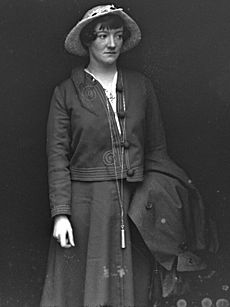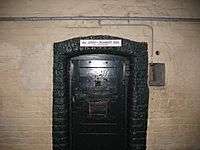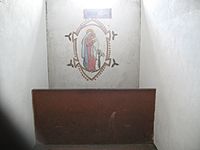Grace Gifford facts for kids
Quick facts for kids
Grace Evelyn Gifford Plunkett
|
|
|---|---|

Young Ireland: Grace Gifford by William Orpen, c. 1907
|
|
| Born | 4 March 1888 Rathmines, Dublin, Ireland
|
| Died | 13 December 1955 (aged 67) Portobello, Dublin, Ireland
|
| Occupation | Cartoonist |
| Spouse(s) | |
| Relatives | 11 siblings, including
|
Grace Evelyn Gifford Plunkett (born March 4, 1888 – died December 13, 1955) was an Irish artist and cartoonist. She was involved in the movement for Irish independence. Grace married her fiancé, Joseph Plunkett, in Kilmainham Gaol just hours before he was executed. This happened because of his role in the 1916 Easter Rising.
Contents
Grace's Early Life and School
Grace Gifford grew up in Dublin, Ireland. Her parents were Frederick Gifford and Isabella Julia Burton Gifford. Her father was a Roman Catholic lawyer, and her mother was a Protestant. They got married in a Protestant church in Dublin.
Grace was one of 12 children. She was the second youngest. The family lived in a nice part of Dublin called Rathmines. The boys in the family were raised Catholic, and the girls were raised Protestant. Grace and her sisters went to Alexandra College.
When Grace was 16, she went to the Dublin Metropolitan School of Art. Here, she studied with a famous Irish artist named William Orpen. He thought Grace was one of his best students. Orpen often drew pictures of her. He even painted her for a series called 'Young Ireland'. Around this time, Grace also discovered her talent for drawing funny pictures, called caricatures. In 1907, she studied art in London at the Slade School of Art.
Grace's Career as an Artist
Grace came back to Dublin in 1908. It was hard for her to make a living as a caricaturist. She published her cartoons in different magazines like The Shanachie and The Irish Review. Joseph Plunkett edited The Irish Review starting in 1913.
Even though she didn't earn much money, Grace had an active social life. She met Joseph Plunkett for the first time at a new Irish-speaking school called Scoil Éanna. Joseph was a friend of her brother-in-law, Thomas MacDonagh. Thomas was married to Grace's sister, Muriel. Thomas MacDonagh later became one of the leaders of the 1916 Easter Rising.
Engagement and Marriage
Grace became more interested in the Catholic religion. This brought her closer to Joseph Plunkett. He came from a very Catholic family. In 1915, Joseph asked Grace to marry him, and she said yes. Grace then officially joined the Catholic Church in April 1916. They planned to get married on Easter Sunday that year.
Grace's parents were not happy about her marrying Joseph. He was very ill at the time.
After the Easter Rising, Grace's brother-in-law, Thomas MacDonagh, was executed on May 3. On that same day, Grace learned that Joseph was also going to be executed. She quickly bought a ring in Dublin. With the help of a priest, she convinced the military to let them marry. Grace and Joseph got married on the night of May 3 in the chapel of Kilmainham Gaol. This was just a few hours before he was executed.
Grace and Sinn Féin
After Joseph's death, Grace Plunkett decided to use her art to support Sinn Féin. This was a political party working for Irish independence. She also continued her work as an artist to earn money. In 1917, she was chosen to be part of the Sinn Féin leadership.
Her sister Muriel, who was Thomas MacDonagh's widow, died in 1917. Grace helped care for Muriel's two children, Donagh and Barbara. She shared this responsibility with her oldest sister, Katherine, until 1919. Grace was a loving aunt to them throughout her life.
Life After the Civil War
During the Irish Civil War, Grace Plunkett was arrested in February 1923. She was held in Kilmainham Gaol for three months. While there, she painted pictures on the walls of her cell. One of these was of the Blessed Virgin and the Christ Child. She was released in May 1923.
After the Civil War, Grace had no home and little money. Like many who opposed the Anglo-Irish Treaty, she faced social difficulties. It was hard for her to find work. Her artistic talent was her main way to earn a living. Her cartoons appeared in newspapers and magazines like Dublin Opinion and The Irish Tatler. She also illustrated a book by W. B. Yeats in 1930.
Grace moved between rented apartments. She made many friends but did not want to remarry. Her financial situation improved in 1932. The government, led by Éamon de Valera, gave her a special pension. This helped her with money worries. It also allowed her to visit Paris sometimes, where she loved going to art galleries. For many years, she lived in an apartment in Nassau Street.
Grace's husband, Joseph, had left everything to her in his will. However, his parents refused to give her anything. The will was not legally valid because it only had one witness. Also, the marriage happened after the will was made, which made it void. For years, Grace received nothing. In 1934, she started legal action against Joseph's parents. They settled the case outside of court. Grace received £700, plus her legal costs.
Later in life, Grace's health declined. In 1950, she went to St Vincent's Hospital. She then stayed in a nursing home, but she did not like it because it limited her freedom.
Grace Gifford Plunkett died suddenly on December 13, 1955. She passed away in her apartment in South Richmond Street, Dublin. Her funeral was attended by President Seán T. O'Kelly. She was buried with military honors in Glasnevin Cemetery.
Cultural Impact
Grace Gifford is the subject of a popular song called "Grace." Frank and Seán O'Meara wrote the song in 1985. Many musicians have recorded it. The song became very popular in Ireland and other places.





